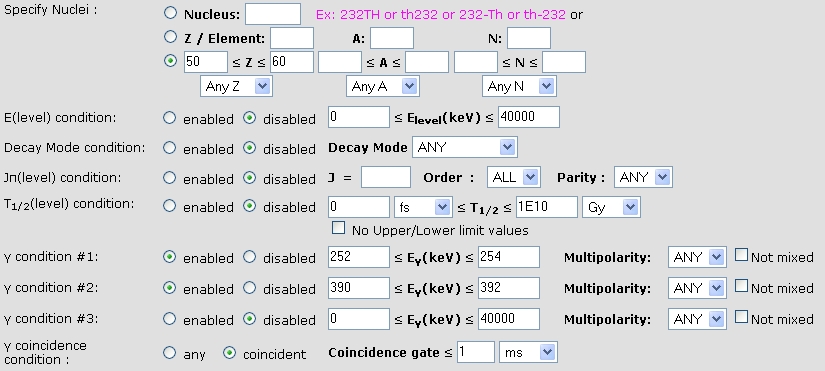Help on Nuclear Levels and Gammas Search
Overview
The search form allows to retrieve nuclear information from the current ENSDF Adopted Levels, Gammas files.
Retrieval parameters can be put in the search form using text boxes, drop-down menus and radio buttons. The Nucleus text box can take nuclear names, the Element text box takes element names, the remaining text boxes can only take numbers.
Please note that the corresponding radio button should be clicked on enabled for many of the conditions to take effect. Javascripts have been implemented to facilitate the use of the radio buttons; however, the user must pay attention to them.
Search Feature Examples
A few examples should clarify many of the search features.
Search on 144DY:




Search on nuclei heavier than Sn and lighter than Yb that alpha-decay:

Search on nuclei heavier than Sn and lighter than Yb that alpha-decay, excluding the ground state:

Search for the first 2+ states in even-Z, even-N Sm (Z=62) nuclei:

Search for excited states with energy larger than 500 keV and half-lives in the microsecond range for N=70-80. In this example, we checked on "No upper/lower limits values" to suppress results like "T1/2 > 20 NS" which would be listed otherwise:

Search for excited states with JPi=10+ that decay with an E2 200-300 keV gamma ray for A=140-150. In this case gamma rays with mixed multipolarity will be listed, for instance M1+E2 or E2+M3. To search for pure E2 transitions, check on "Not mixed":

Search for nuclei, with Z=50-60, a 252-254 keV gamma ray and a 390-392 keV gamma ray in their level scheme:

In this example, the coincidence condition between the 2 gammas rays is set as any, if we would like to search for gamma rays that are part of a same gamma-ray cascade, one should set the condition to coincident. The sum of the level's half-lives belonging to the cascade ( tSum ) is used in conjunction with the coincidence gate (coinGate) to restrict the search. We assume that if coinGate < tSum/10 the coincidence is delayed, if coinGate > tSum/10 the coincidence is prompt. The query will only retrieve prompt coincidences.
A triple-gamma coincidence search is also implemented. It works the same way as the double-coincidence search.
Gamma coincidence searches can easily exhaust the database resources and the query may take a long time to execute. Consequently, it is a good idea to restrict the search space as much as possible. At the moment, the gamma-ray's energy range has to be smaller than 8 keV for double-gamma coincidences and 4 keV for triple-gamma coincidences. Additionally, the Decay Mode, Jπ and T1/2 conditions are not applicable in the gamma-gamma searches.
Search for gamma ray transitions for Sn nuclei with pure E2 multipolarity and non-zero gamma reduced transition probability:

Output type
There are 2 possibilities, both of them are ASCII files with HTML elements to facilitate the viewing using a browser. In one of them, Web Page option, results are presented in a HTML table. In the other, Formatted File option, the presentation is far simpler; results are separated by a tab key.
The Formatted File option is suitable for further parsing by a computer code. A header with the name of the each column is given. Due to space limitations, many names are abbreviated:
- Energy: Level energy in keV.
- JPi: Level spin and parity.
- T12 (txt): Level half-life in the format value+units+uncertainty.
- T12 (seconds): value of the level half-life in seconds. Levels that are stable are assigned an "infinity" value.
- E Gamma: Gamma energy in keV.
- I Gamma: Gamma intensity.
- M Gamma: Gamma multipolarity.
- M Ratio: Gamma mixing ratio.
- Unc: Uncertainties of the closest left column quantity.
Please, don't hesitate to email your comments.
Additional Resources
Database Manager and Web Programming:
Alejandro A. Sonzogni
sonzogni@bnl.gov
Navigation
